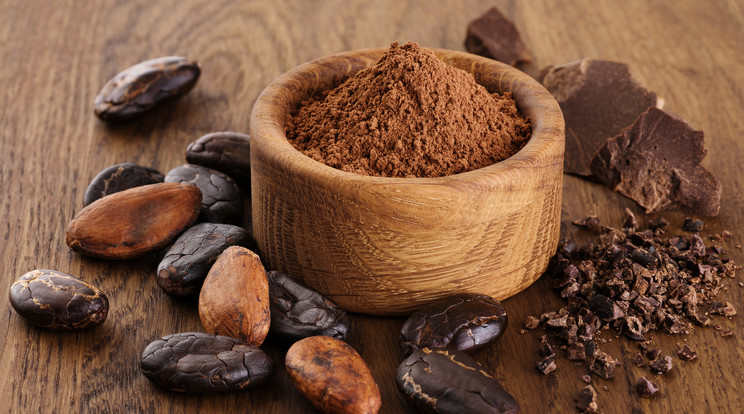About cocoa
Cocoa (Theobroma cacao) is a member of the Bytnerioideae subfamily of the Malvaceae family. Two other members of the plant family, the comaza (Theobroma grandiflorum) and the mocambo (Mocambo tree, Jaguar tree - Theobroma bicolor), are also grown.
Plant morphology
Cocoa is a tree that grows to a height of 5-10 meters. Four brown, thick cotyledons are at a 90o angle to each other. The plant produces its male flowers on older, 2-3 year old woody parts (this is called cauliflower, i.e. stem (self) flowering or branching), which are pollinated by insects (in rare cases self-pollination is also possible). The flowers can open all year round, but there is no continuous harvest, so a maximum of one or two harvests is possible: one in October-December and one in March-April.
Cocoa is a beautiful example of bone flora
The pods of cocoa hanging one by one can reach a size of 30 cm and a weight of 800 g. The approx. The 2.5 cm diameter seeds (the cocoa beans) - of which there can be up to 60 in one fruit - are arranged in 5 rows in the fruit flesh. At the end of ripening (5-7 months), the flesh begins to separate from the seeds.
The importance of cocoa in numbers
Cocoa is grown mainly in the vicinity of the Equator, in the areas between the northern and southern latitudes of the 10th world. 8.5 million hectares. The annual yield has been around 4 million tons in recent years. Major producers include Côte d’Ivoire, Ghana, Indonesia and Nigeria, and traditional cultivation is even carried out in Brazil and Ecuador. The largest importers are the United States (40%) and the European Union (43%), including the Netherlands.
Growing cocoa
Today, three main varieties of cocoa are grown, Criollo, Forastero and Trinitario. The Criollo and Trinitario varieties are typically found in South America, while the Forastero variety is mainly found in Africa. The following subheadings will cover each variety in more detail.
Cocoa cultivation is typically carried out in areas with a tropical climate, with a minimum of 1500-2000 mm of rainfall per year. Cocoa is shade-tolerant (therefore, when planted, fast-growing legumes are planted next to cocoa) but also grow in a place fully exposed to sunlight. Requires acidic or slightly acidic soils. Its thermal optimum is 25-28 oC, it cannot withstand temperatures below 20 oC.

Manual harvest in Colombia
Cocoa is propagated by shoot cuttings or from seed (it needs shade for successful propagation). Depending on the conditions of the area and the type of cocoa, 800-1600 trees are planted per hectare (2.5-3.5 x 2.5-3.5 square meters). The spreading crown shape is formed by incision, after which a thinning incision should be made only if necessary. The trees become productive in 3 years and able to produce the highest yields from the age of 10 up to the age of 30. Healthy plants grow economically until they are 60 years old. Harvest time is fully ripe with a knife in October-December.
Varieties of cocoa
According to their great chocolate lords, the finest dark chocolate is made from the Criollo (the word means “native”) variety. Its unmistakable taste is not missing from its special appearance (characteristic reddish color), which is unusual at first for consumers of the other two types of chocolate: caramel, walnut and vanilla, with some stronger-pungent punches. Criollo has been a rarity since the 1900s as it is a less resistant variety than Trinitario or Forastero. In our age, Criollo is genetically closer to Trinitario than the original Criollo. The most important Criollo varieties are the Venezuelan trio, ‘Ocumare 61’, ‘Porcelana’ and ‘Chuao’.
Criollo variety in traditional packaging
Forastero is the most widespread and most widely produced variety of cocoa beans in the world. Originally from the Amazon, its plantations can now be found all over the world. In Spanish, Forastero means a foreigner, a foreigner, a newcomer, because at the time of colonization, the Spaniards produced domestic cocoa in Venezuela (Criollo in Spanish), and the Amazon rural cocoa was a foreigner (forastero) to them. The most common version of Forastero is ‘Amenolado’, which is mainly produced in Brazil and West Africa. Most Forastero varieties are produced in large quantities and in medium quality. Exceptions to this are some Ecuadorian varieties, such as ‘Cacao Nacional’ and ‘Arriba’ Forastero, which, like the other two varieties, serve as the raw material for the best quality dark chocolates.
The mixture of Trinitario, Criollo and Forastero cocoa varieties comes from Trinidad. This kind is even called “sent from heaven”. A XVII. At the end of the 18th century, Criollo trees were planted on the island of Trinidad. century was decimated by a serious epidemic. It was then that Forastero was planted on the island, and especially one of its more resistant variants, the already mentioned ‘Amenolado’, in place of the Criollos, which, mixed with the decimated Criollo herd, created the Trinitario variety. In the XIX. During the 20th century, the Trinitario variety spread throughout the world and is now found in Cameroon, Sri Lanka, Java, Papua New Guinea, Venezuela and Ecuador.
Today, Trinitario has also become the most common variety in the market for quality dark chocolate. The Venezuelan ‘Carenero’ and ‘Rio Caribe’ versions are especially respected by lovers of the best quality dark chocolates. In contrast, Cameroon’s Trinitario is of medium quality and is therefore found primarily in mass-produced chocolates.
Content of cocoa
Cocoa beans have a fat content (which is practically cocoa butter) of 50-60%, a protein content of 12-16%, a starch content of 7%, and 0.2% caffeine, theobromine and catechin.
Cocoa beans
Processing and using of cocoa
The fruits are cut with a knife without damaging the seeds. The harvested seeds are fermented (3 days for Criollo and 6 days for Forastero). In conventional cultivation, this is done with a banana peeler. The acetic acid produced during fermentation kills the embryo in the nucleus, and the enzymes released (polyphenol oxidase, which is also responsible for the browning of the apple, for example) oxidize the catechin so that it can bind the alkaloids. Approximately 20 fruits will be in 1 kg of dry cocoa beans.
After drying, which is kept at 60-70 oC for 1 week or less per day, it is classified and exported. Roasting takes place in the country of use at 90-140 oC for 10-45 minutes, after which is peeled and ground into a paste. It is mainly used to make chocolate, cocoa powder and cocoa butter: cocoa paste is mixed with cocoa butter, sugar and milk powder and then pressed into chocolate (cocoa butter is also obtained by pressing). For quality cocoa powder, 2/3 of the cocoa butter must be extracted. The empty cocoa shell is very suitable for firing or feeding.
Criollo and Trinitario are known as rare, fine and aromatic cocoa, while the smaller-seeded Forastero is used in mass production with a higher yield. Currently, Forastero cocoa accounts for more than 90 percent of cocoa bean production, with the remaining ten percent being shared by Criollo and Trinitario.
Curiosities
Cocoa is believed by the Aztecs to be the “drink of the gods” that their chief god brought them out of His kingdom. As a result, cocoa was used as a protagonist in many religious rituals, and since the beans of the highly valued plant were also extremely valuable, they also functioned as a means of payment. Spanish conquistadors have also discovered the potential of cocoa and exploited its many flavoring possibilities (e.g., fooled with chili).
[Forrás: https://agroforum.hu/blog/haz-taj/mindent-a-kakaorol]
